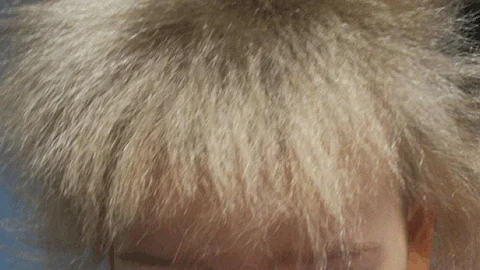The Science of UHS
Under the microscope, UHS hair reveals its secrets: unlike the smooth, tubular shape of typical hair, UHS strands are triangular or angular with grooves running along their length. This unique structure makes the hair brittle and almost impossible to tame. Scientists have also found premature keratinization in the hair's inner root sheath, adding to the challenge.
Yet, mysteries remain. Some individuals with UHS don’t carry mutations in the identified genes, suggesting there’s more to uncover about this rare condition. [2]
How Is Uncombable Hair Syndrome Diagnosed?
To diagnose uncombable hair syndrome, your child’s healthcare provider will begin with a thorough medical history and a physical examination. The distinctive symptoms of this condition typically allow for diagnosis through a visual inspection of the hair on the scalp.
Tests for Diagnosing Uncombable Hair Syndrome
To confirm the diagnosis, the provider may recommend:
Hair Shaft Test: A strand of hair is removed and examined under a microscope. Irregularities in the hair shaft’s shape can confirm the condition.
Genetic Test: A small blood sample is analyzed for genetic mutations associated with uncombable hair syndrome. Detecting such mutations confirms the diagnosis.
Management and Treatment
Currently, there is no specific treatment for uncombable hair syndrome. However, managing the condition and simplifying hair care routines can make coping easier. Recommendations include:
Avoid harsh chemical treatments like perms or dyes, as they may worsen symptoms or have little effect.
Minimize brushing or combing to prevent additional hair damage.
Limiting the use of heat-styling tools like curling irons or blow dryers.
Keeping the hair regularly trimmed to reduce tangles and make maintenance more manageable.
Biotin supplements have shown promise in some cases, as they are known to improve nail fragility and support hair growth, with noticeable effects typically seen after four months of supplementation.
By following these care strategies, you can help make your child’s hair care routine less stressful. [3]
Hope for the Frizz Fighters
While UHS may sound like a lifelong struggle, it often resolves on its own as children grow. For those living with this rare condition, a combination of patience, gentle hair care, and research advancements offers hope for more manageable days ahead.
So, the next time you battle a little frizz, remember: your hair woes could be much wilder. For some, their locks are a genetic masterpiece—unruly yet extraordinary. So, here’s to celebrating the wild, untamed, and utterly unforgettable strands that make every story uniquely dazzling!
References:
1. Calderon P, Otberg N, Shapiro J. Uncombable hair syndrome. Journal of the American Academy of Dermatology. 2009 Sep 1;61(3):512-5.
2. Osmosis.org. (2024). Osmosis. [online]Available at: https://www.osmosis.org/answers/uncombable-hair-syndrome.
3. Smith-Garcia, D. (2022). All About Uncombable Hair Syndrome. [online] Healthline. Available at: https://www.healthline.com/health/uncombable-hair-syndrome#causes [Accessed 24 Dec. 2024].
By Josna Lewis
MSM


